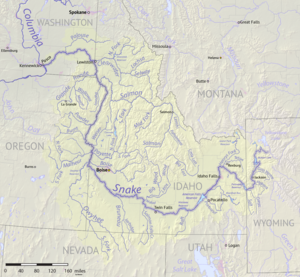The national conservation group American Rivers, in its annual most endangered rivers report, has placed the Snake River in Oregon, Washington and Idaho at the top of the list. The main threat, the group says, are the four federal dams on the lower Snake River.
“No river in the country is more in need of bold, swift action than the Pacific Northwest’s Snake River. For years, Northwest tribes and local leaders have called for more effective efforts to save endangered salmon. Now, after decades of delay and half-measures by the federal government, salmon are slipping closer to extinction. The loss of salmon runs is not only a crisis for the ecosystem, it is a crisis for Indigenous people who depend on these iconic fish for their identity and culture,” says American Rivers in its report.
“Climate change is making the need for action on the Snake River more urgent. As temperatures rise, the river’s water is heating up. If salmon are to survive in a warming world, they need the refuge of the Snake River basin’s cold, pristine mountain streams. Scientists say removing the four federal dams on the lower Snake River must be part of any strategy to recover Snake River salmon,” says the report.
From the report:
“The Pacific Northwest has a once-in-a-lifetime opportunity to honor treaties and commitments with Northwest Native American tribes and revitalize the region’s economy through restoring abundant numbers of Snake River basin salmon and invigorating clean energy, agriculture and recreational opportunities.
“In February 2021, Congressman Mike Simpson (R-ID) proposed a $33.5 billion framework that includes critical river restoration measures regionwide, including but not limited to the restoration of the lower Snake River by removal of the four dams. It would be the biggest river and salmon restoration effort in history. His proposal also includes investments to replace the energy produced at the dams and increase the energy grid’s reliability, and upgrade transportation and irrigation services that the lower Snake River dams currently provide, and support community needs.
“The Pacific Northwest has a track record of crafting innovative, bipartisan solutions to challenging water and river issues. The Northwest congressional delegation must bring together the governors, tribes and stakeholders to build upon Congressman Simpson’s framework, ensuring it is as strong as possible and meets the region’s urgent needs. A well-crafted, collaboratively developed, comprehensive solution would benefit not only the Northwest, but also the nation as a whole by restoring salmon runs, bolstering clean energy and strengthening the economy of one of the most dynamic regions in the country.
“Congressional leaders from both major political parties should introduce legislation and ensure it advances as part of President Biden’s national infrastructure legislation.”
Here’s the American Rivers list:
#1: Snake River (ID, WA, OR)
Threat: Four federal dams on the lower Snake River
#2: Lower Missouri River (MO, IA, NE, KS)
Threat: Outdated river management and flooding fueled by climate change
#3: Boundary Waters (MN)
Threat: Pollution from proposed sulfide-ore copper mining
#4: South River (GA)
Threat: Sewage pollution due to lax enforcement
#5: Pecos River (NM)
Threat: Pollution from proposed gold, copper and zinc mining
#6: Tar Creek (OK)
Threat: Pollution from Tar Creek Superfund Site
#7: McCloud River (CA)
Threat: Raising of Shasta Dam, flooding state Wild and Scenic River
#8: Ipswich River (MA)
Threat: Excessive water withdrawals
#9: Raccoon River (IA)
Threat: Pollution from industrial agriculture and factory farming
#10: Turkey Creek (MS)
Threat: Two major developments exacerbating flood risk

